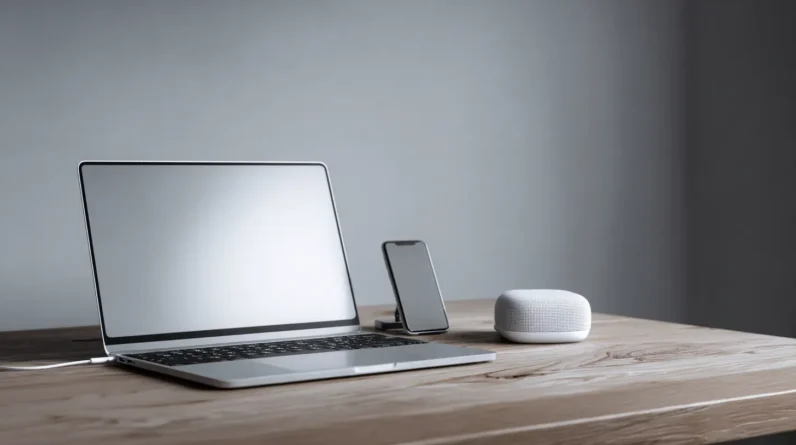
When troubleshooting smart device setup issues, we’ve found that network connectivity is often the culprit. Start by positioning your router centrally and restarting both the router and devices. For larger homes, consider Wi-Fi extenders or mesh networks. Verify your devices are compatible with your chosen ecosystem and communication protocols. During app configuration, connect your smartphone to the same Wi-Fi network and grant necessary permissions. Keep both device firmware and apps updated to resolve glitches and improve performance. Don’t forget to check battery levels regularly, especially for wireless devices. By addressing these common problems, you’ll be well on your way to a smoothly functioning smart home setup.
Network Connectivity Challenges
Network connectivity challenges are the most common hurdles when setting up smart devices. To tackle these issues, we’ll focus on optimizing your Wi-Fi network. First, make sure your Wi-Fi router is centrally positioned to maximize signal strength throughout your home. If you’re experiencing unstable connections, restart both your router and smart devices to refresh connections and resolve temporary glitches.
For larger homes, consider implementing Wi-Fi extenders or mesh networks to eliminate dead zones and maintain consistent connectivity. Regularly update your router’s firmware and smart device software to address compatibility issues and enhance network performance. If problems persist, investigate potential sources of interference and consider adjusting your router’s channel settings. By systematically addressing these factors, we can greatly improve your smart devices’ network connectivity and overall functionality.
Device Compatibility Problems
Incompatibility between smart devices can quickly turn your dream of a connected home into a frustrating experience. When troubleshooting device compatibility problems, we must consider several factors. First, confirm all smart home devices support the same communication protocols, like Wi-Fi, Zigbee, or Z-Wave. Next, verify compatibility with your chosen ecosystem, such as Amazon Alexa or Google Assistant.
To avoid integration issues:
– Check manufacturer specifications and user reviews before purchasing
– Consider devices that support the Matter standard for improved cross-brand compatibility
– Invest in a smart home hub to streamline device management
While the Matter standard promises better interoperability, its adoption is still growing. In the meantime, careful research and planning can help mitigate compatibility challenges. By understanding these factors, we can create a more seamless and frustration-free smart home experience.
App Configuration Difficulties
Many smart device users encounter app configuration difficulties, which can be a significant hurdle in setting up a connected home. To troubleshoot these issues, we’ll focus on key steps to resolve common problems. First, verify you’ve installed the correct app for your specific smart device model. Connect your smartphone to the same Wi-Fi network as the device during setup. Check and enable necessary app permissions, such as location services or Bluetooth access.
Regularly update the app to its latest version for improved features and bug fixes. If connection problems persist, try logging out and back in to refresh the connection. Consult device manuals for model-specific guidance. By following these steps, we can overcome most app configuration challenges. Remember, staying current with app updates and understanding your device’s requirements are essential for a smooth smart home experience.
Software Update Issues
Software update issues can be a significant roadblock in maintaining a smoothly functioning smart home ecosystem. Regularly checking for and installing software updates is vital for peak performance and security of smart devices. Failing to update can lead to compatibility issues, disrupt automation, and expose devices to vulnerabilities.
To address software update issues:
– Check for updates manually within device settings or associated apps
– Enable automatic update prompts when available
– Perform updates to restore functionality of unresponsive devices
Keeping firmware up to date is essential to prevent security breaches and guarantee seamless integration with other devices and platforms. Remember that some devices may require manual checks, while others automatically prompt for updates. By staying vigilant and proactive with software updates, we can maintain the functionality, compatibility, and security of our smart devices, ensuring a smooth and efficient smart home experience.
Power and Battery Concerns
Power and battery concerns are essential factors in maintaining a reliable smart home ecosystem. We must regularly check battery levels of smart devices to prevent connectivity issues. Many devices use red lights to indicate low battery. To prolong battery life, we should adjust settings to minimize power consumption by disabling unused features. High-quality batteries, especially lithium ones, can enhance performance and longevity.
We recommend using smart plugs with energy monitoring capabilities to track power usage and prevent unexpected failures. It’s vital to schedule regular battery checks and replacements to guarantee devices remain operational. For outdoor devices, consider rechargeable or solar-powered battery options. By addressing these power and battery concerns proactively, we can maintain a more stable and efficient smart home system, reducing disruptions and improving overall performance.
Conclusion
We’ve tackled the most common smart device setup hurdles. Coincidentally, as we wrap up, our office smart lights just synced perfectly! Remember, patience is key. If you’re still stuck, don’t hesitate to contact the manufacturer’s support. They’re there to help. With these troubleshooting tips in your arsenal, you’re well-equipped to overcome future setup challenges. Keep exploring and enjoying the convenience of your smart devices. They’re worth the initial effort!







